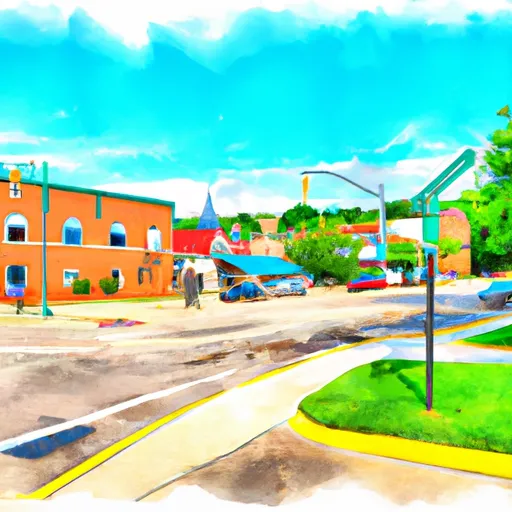-
 Snoflo Premium
Snoflo Premium
Get unlimited access to all our content
With no Ad interruptions! - Start Your Free Trial Login with existing account
Mindoro
Eden Index
Climate
6.6
•
Recreation
2.0
•
Community
2.2
•
Safeguard
3.9/10

Mindoro is a small village located in La Crosse County, Wisconsin. The climate in Mindoro is characterized by warm summers and cold winters. Summers are mild and pleasant, with average temperatures ranging from the mid-70s to mid-80s Fahrenheit, while winters are colder with temperatures dropping below freezing and occasional snowfall.
The village is situated near the Trempealeau River, which provides a significant hydrological feature to the area. The river serves as a recreational spot for fishing enthusiasts, offering opportunities to catch various species such as smallmouth bass, walleye, and catfish. Additionally, the river serves as a water source for canoeing and kayaking activities, providing a scenic and serene experience.
In terms of outdoor recreation, Mindoro offers various opportunities for nature lovers. The area is surrounded by lush forests and picturesque landscapes, making it ideal for hiking, bird-watching, and camping. The nearby Perrot State Park, located just a short drive away, offers stunning views of the Mississippi River, along with hiking trails, picnic areas, and camping facilities.
Overall, Mindoro, Wisconsin presents a favorable climate, a beautiful hydrological setting, and a range of outdoor activities for residents and visitors to enjoy.
What is the Eden Index?
The Snoflo Eden Index serves as a comprehensive rating system for regions, evaluating their desirability through a holistic assessment of climate health, outdoor recreation opportunities, and natural disaster risk, acknowledging the profound impact of these factors on livability and well-being.
Climate Health Indicator (CHI): 6.6
Mindoro receives approximately
869mm of rain per year,
with humidity levels near 82%
and air temperatures averaging around
8°C.
Mindoro has a plant hardyness factor of
4, meaning
plants and agriculture in this region thrive during a short period during spring and early summer. Most
plants will die off during the colder winter months.
By considering the ideal temperature range, reliable water supplies, clean air, and stable seasonal rain or snowpacks, the Climate Health Indicator (CHI) underscores the significance of a healthy climate as the foundation for quality living.
A healthy climate is paramount for ensuring a high quality of life and livability in a region, fostering both physical well-being and environmental harmony. This can be characterized by ideal temperatures, reliable access to water supplies, clean air, and consistent seasonal rain or snowpacks.
Weather Forecast
Streamflow Conditions
Upper Mississippi-Black-Root
Area Rivers
Upper Mississippi-Black-Root
Snowpack Depths
Upper Mississippi-Black-Root
Reservoir Storage Capacity
Upper Mississippi-Black-Root
Groundwater Levels
Recreational Opportunity Index (ROI): 2.0
The Recreational Opportunity Index (ROI) recognizes the value of outdoor recreational options, such as parks, hiking trails, camping sites, and fishing spots, while acknowledging that climate plays a pivotal role in ensuring the comfort and consistency of these experiences.
Access to outdoor recreational opportunities, encompassing activities such as parks, hiking, camping, and fishing, is crucial for overall well-being, and the climate plays a pivotal role in enabling and enhancing these experiences, ensuring that individuals can engage in nature-based activities comfortably and consistently.
Camping Areas
| Campground | Campsites | Reservations | Toilets | Showers | Elevation |
|---|---|---|---|---|---|
| Merrisach Lake Park - Merrisach Lake | None | 169 ft | |||
| Warfield Point Park | None | 132 ft | |||
| Cuivre River State Park | 94 | 658 ft | |||
| Float Camp | 16 | 472 ft | |||
| Deer Leap | 46 | 338 ft | |||
| Leroy Percy State Park | None | 108 ft | |||
| Great River Road State Park | None | 150 ft | |||
| Lake Chicot State Park | None | 128 ft | |||
| Lake Charlie Capps | None | 146 ft | |||
| Chicot County RV Park | 98 | 111 ft |
Nearby Ski Areas
Catastrophe Safeguard Index (CSI):
The Catastrophe Safeguard Index (CSI) recognizes that natural disaster risk, encompassing floods, fires, hurricanes, and tornadoes, can drastically affect safety and the overall appeal of an area.
The level of natural disaster risk in a region significantly affects safety and the overall livability, with climate change amplifying these risks by potentially increasing the frequency and intensity of events like floods, fires, hurricanes, and tornadoes, thereby posing substantial challenges to community resilience and well-being.
Community Resilience Indicator (CRI): 2.2
The Community Resilience Indicator (CRI) recognizes that education, healthcare, and socioeconomics are crucial to the well-being of a region. The CRI acknowledges the profound impact of these elements on residents' overall quality of life. By evaluating educational resources, healthcare accessibility, and economic inclusivity, the index captures the essential aspects that contribute to a thriving community, fostering resident satisfaction, equity, and social cohesion.

